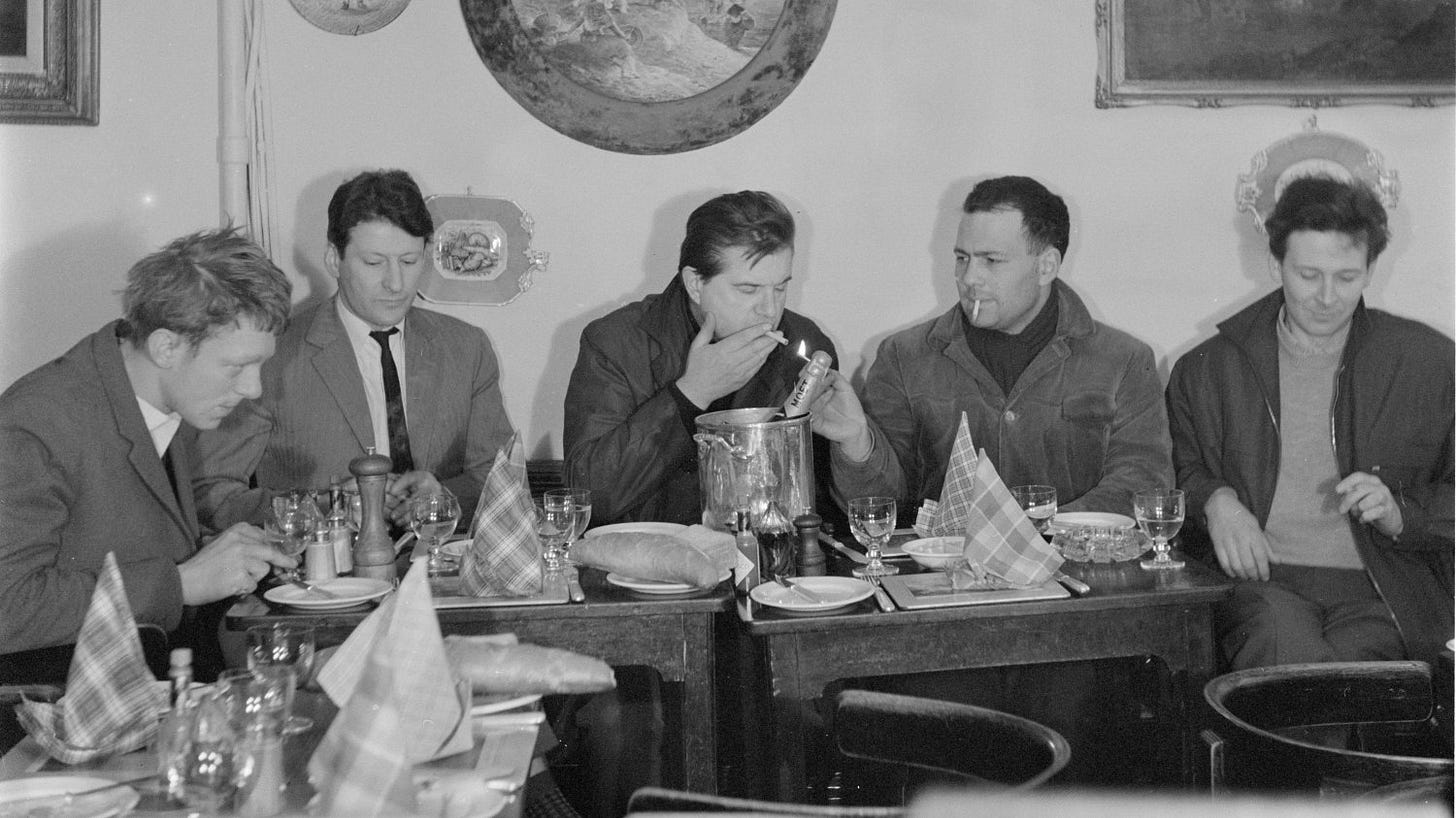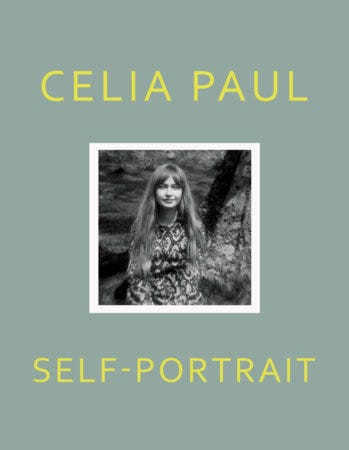Hardboiled, Scrambled, Over Easy, or Poached
no matter your preference, it's not about the eggs
“There is a famous photograph by John Deakin taken in 1963 of the most celebrated painters in London at the time: Lucian Freud, Frank Auerbach, Francis Bacon, Michael Andrews. They are in animated conversation with each other. They are obviously discussing art. They are showing off, and there is definitely rivalry, but they are being inspired by each other, too.”
— Celia Paul1

If one wrote an obscure newsletter once a week or so focused on food, books, and curiosities that catch one’s fancy, one would not, in all likelihood, write about Celia Paul. But this week Paul — a celebrated British artist, known best for her intimate portraits and landscapes — quietly made herself at home in my brain. First, I stumbled across her forthcoming monograph during a leisurely browse of the MACK publishing site. Then Karl Ove Knausgård showed up on Paul’s doorstep and brought her to mine via The New Yorker. Next, a subsequent search to learn more about Paul sent me down a rabbit hole of superstar writers (Zadie Smith, Hilton Als) reflecting on her significance as an artist, writer, and decidedly committed hermit.
Paul keeps to a rigorously ascetic routine, rising at 5 AM. She takes a cup or two of tea and works until 1 PM, at which point she spends a few hours reading and resting before re-evaluating the morning’s work. She began painting at age fifteen and muses that she’s rarely missed a day of practice since. While working as a tutor at Slade School of Fine Art, Lucian Freud (then 55) became artistically and sexually interested in Celia (age 18). Freud famously painted her (along with an entire roster of women) in less-than-comfortable portraits. Zadie Smith explains, Paul is not “as has been assumed, the tale of a muse who later became a painter, but an account of a painter who, for ten years of her early life, found herself mistaken for a muse, by a man who did that a lot.”2
Freud and Paul had a child together, and during this time, Paul became one of his main sitters, appearing in the below painting, for which she held such high distaste that she executed her own version in 2022, Ghost of a Girl with an Egg. In Paul’s words, “‘Ghost of a Girl with an Egg is my re-encounter with Lucian Freud’s 1980 portrait of me, titled Naked Girl with Egg. I was 20 when Lucian painted his first portrait of me; he was 57… The experience of lying naked in front of Lucian was too emotionally painful for me. I refused his requests to lie naked for him again. By comparing my breasts to eggs, he objectified me. Yet did I also, in some way, want to be objectified? This is a question I often ask myself.”3
The egg is, therefore, both the entire point of the work and irrelevant to it. It can be seen as the most humble of foods and as a marker of the imbalance in the relationship between creator and subject. The egg becomes a vehicle for meaning, but on its own, it signifies little.
Paul eventually left Freud and found love with Steven Kupfer, her husband of ten years. However, Paul and Kupfer never shared a home, nor did she reside with her son Frank, who primarily resided with Paul’s mother. According to Frank, “Isolation is deeply important to my mum’s peace of mind…. Her studio, which no-one else may enter without permission, is a mass of splintered floorboards, paint spatters and canvases, but, like [her] bedroom, it’s devoid of any adornments which others might find necessary for a sense of self-assurance. One might conclude from this that my mum is an entirely self-subsistent person, yet she feels separation keenly, as well as a deep guilt that her need for solitude precludes her from being as hospitable as she would like to be.”4 This isolation feels at once both necessary and an enormous hindrance. “I’m not a portrait person. If I’m anything, I have always been an autobiographer,” Paul declares. As such, she paints the stuff of life: grief, meditation, longing, love, and sustenance all appear as central themes in the faces of her subjects. Like the egg, the subjects are portals to the universal human experience. And yet. While Paul exerts creative control over her environment and its objects, one must wonder what more might be possible if her daily existence was a bit more of the world.
In preparation for an upcoming exhibit, Paul reimagined the Deakin photograph, all but erasing the stuff of life: unsliced bread, Moët champagne, water, cigarettes. The viewer is greeted by a lineup of men not in relation with each other but in relation with the onlooker. Expressions inscrutable, on display at arm’s length, these men are unquestionably submissive to the woman wielding the brush.
The thing about the original lunch is that it was staged5. Whether or not the champagne cork was popped remains a mystery. This was not the stuff of real life; this was the stuff of carefully arranged art. A notable drunk and photographer, Deakin took on the puff assignment to photograph the painters for the British society magazine Queen (now Harper’s Bazaar). Paul’s version removes all the distracting props and gets right down to business, zeroing in on the men themselves. Without the edible detritus, the men cannot hide.
Many of you are better positioned to philosophize about Paul. I welcome your thoughts in the comments below. How do the everyday things of life—the thrice-daily meals, the animal bodies we inhabit, and the emotions that permeate our relationships with others—influence, inspire, or distract us?
For those who want to learn more…

Speaking of Celia’s and eggs…
I ran into a lovely Penguin Random House rep I used to work with a few weeks back, and she connected me with a copy of Ali Smith’s latest. I am a huge fan of Smith, especially the seasonal quartet she released between 2017 and 2021, so I was eager to dive in. Gliff takes place “in an uncertain near-future, ” of the dystopian sort. Two siblings return home one day to find their house encircled in a thick ribbon of red paint. This, combined with a visit to their mother at a job that appears to be more like a prison, sets the reader off on a path to fill in the gaps of what exactly is going on in this “brave new world.”6
The language is spare, but the prose is saturated with literary references. Puns, allusions, irregular typography, and punctuation are just some of the devices Smith employs as she smashes both grammar rules and respect for authority to bits. All that’s missing is a brilliant literary professor to help me make sense of it all. I’ll be giving this a second read.
I Still Make the Chocolate Cake From This Sexy 1976 Cookbook
In stark contrast to Paul’s dissatisfaction with Freud’s depiction of her body, an excellent piece (and recipe) from Jessica Carbone on Janice Feuer Haugen’s Chocolate Decadance. This book, published by an independent Berkeley-based press, was the result of a chef attempting to pass Feuer Haugan’s daringly good cake off as his own. Julia Child was a fan, writing Feuer Haugen that her husband Paul “particularly enjoyed [the drawings], and savored every bit of it, while I savored every page of the recipe.”
Inside Walton Goggins’s Enchanting 1920s New York Lodge
Finally, if you need to find me, I’ll be cooking in Walton Goggins + Nadia Conners’ kitchen, sitting in their romantic living room with a cappuccino as the sun comes up, mixing a drink in the prohibition bar, and curling up in front of their very practical fireplaces. Goggins stars in Season Three of The White Lotus. I inhaled episode one yesterday and I already have many theories about whodunnit that will surely be quickly debunked. Care to discuss in the comments?
https://astra-mag.com/articles/celia-paul-up-from-the-burning-bracken/
https://www.nybooks.com/articles/2019/11/21/muse-easel-celia-paul-lucian-freud/
https://www.victoria-miro.com/news/1843
https://www.thenation.com/article/culture/celia-paul-self-portrait-review/
https://www.thetimes.com/magazines/culture-magazine/article/lucian-freud-francis-bacon-and-their-anti-hero-photographer-friend-bwv5ndxxc#:~:text=Deakin%20was%20invited%20by%20Francis,banquet%20in%20Luis%20Buñuel's%20Viridiana.
The book is a reimaginging of the 1932 classic by Aldous Huxley, which I have not read.











Notes on the Cost of Eggs. https://shorturl.at/xTn1R